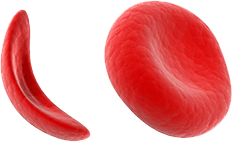Sickle Cell
 Sickle Cell Anaemia is a genetic disorder that leaves no family member unscathed. This condition is found in people whose ancestors originate from Africa, Asia, the Mediterranean Islands, South America and the Middle and Far East.
Sickle Cell Anaemia is a genetic disorder that leaves no family member unscathed. This condition is found in people whose ancestors originate from Africa, Asia, the Mediterranean Islands, South America and the Middle and Far East.
Where a couple both have the Sickle Cell Trait, each time that they are expecting a child, there is a:
- 1 in 4 chance that their child will inherit an usual haemoglobin combination
- 2 in 4 chance a Sickle Cell Trait just like the parents
- 1 in 4 chance Sickle Cell Anaemia, a serious blood disorder.
The red blood cells of people with Sickle Cell Anaemia, and other types of Sickle Cell syndromes, change into a ‘sickle shape’ when they give up their oxygen to the body’s tissues. These red cells are fragile, becoming hard, rigid, brittle and break easily.
People with this condition are anaemic because their red blood cells have a shorter life in circulation, only 15-30 days, instead of the 120 days life span of a normal red blood cell. Sometimes, due to their shape, these Sickle Cells can clog together and block the small blood vessels in the body. Due to this blockage, vital oxygen cannot get through to the affected part of the body. This leads to pain. If this blockage is not corrected the pain intensifies and can become excruciating. These episodes are called ‘Sickle Cell Crises’.
The frequency of a ‘crisis’ is unpredictable. The cause of each episode is often unknown although it may be triggered by certain situations such as cold weather, infection, stress or unemployment. Sickle Cell can make life very difficult for the sufferer, family and friends.







